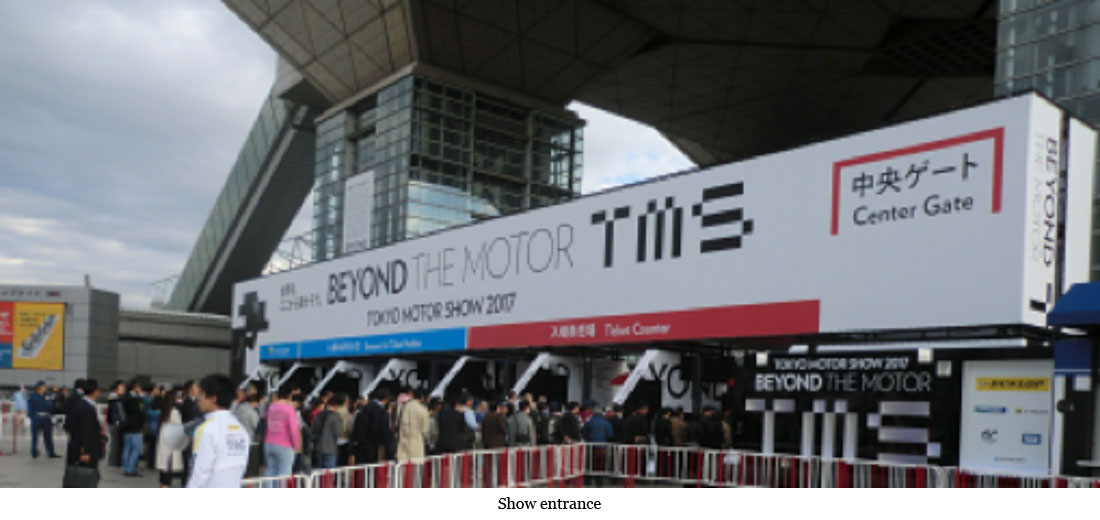The Tokyo Big Sight venue features excellent access on public transportation, located just adjacent to the nearest train station. After exiting the station, visitors need only to walk over the pedestrian overpass to reach the massive exhibition site towering before their eyes.
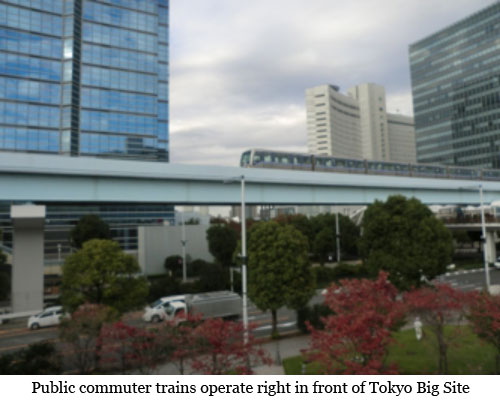
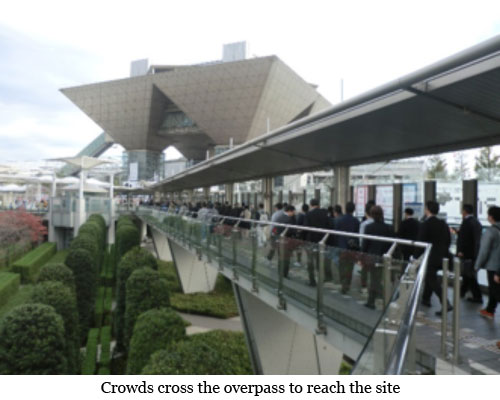
This year’s exhibitions were staged in three separate Big Sight facilities – the East Halls, New East Halls and West Halls. JAMA motorcycle manufacturer member booths were set up in the New East Halls, which can be reached after passing through the East Hall from the entrance.
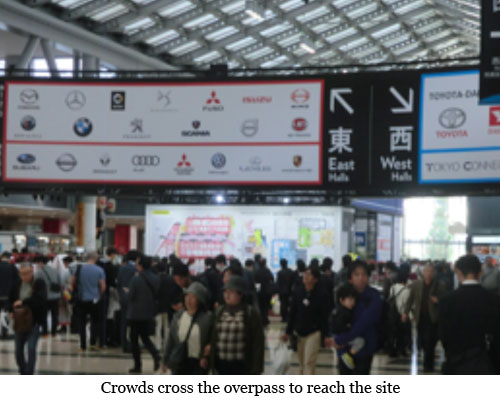
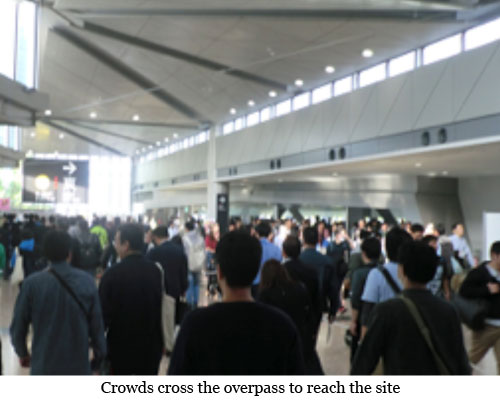
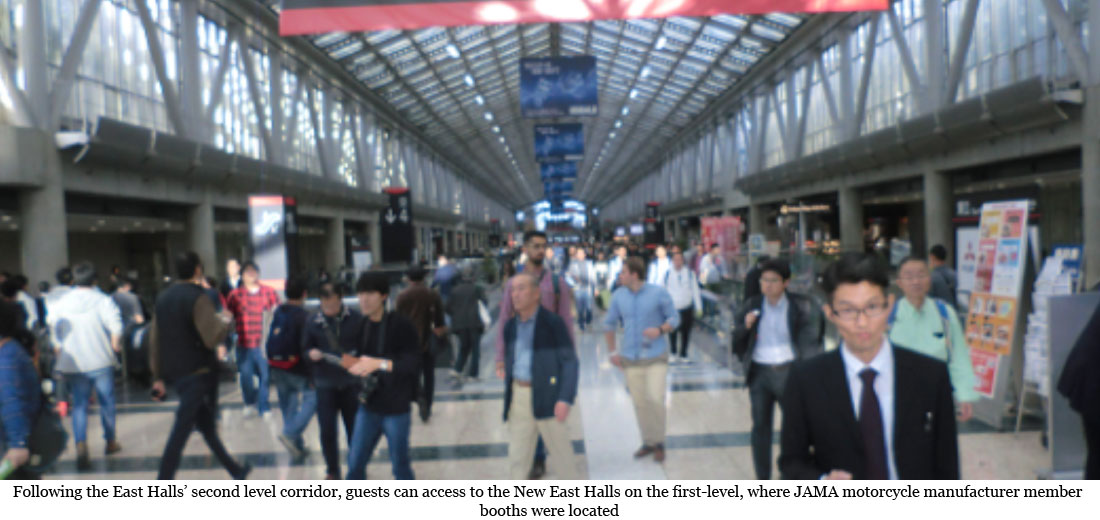
Honda
At the pre-show press briefing held on October 25, the president and Representative Director of Honda Motor Corporation, Mr. Takahiro Hachigo, commented on his company’s defining motto: “Serve people worldwide with the joy of expanding their life’s potential.” President Hachigo went on to further note: “Amongst others, Honda has been commercializing hybrid, plug-in hybrid and electronic vehicles to realize ‘pleasure of utile’ and ‘fun to drive’ by those products”. He also used the occasion to unveil “Honda Riding Assist-e”, an electronic motorcycle concept model.
This concept model showcases the motorcycle-format application of original balance control technology cultivated by Honda through in-house robotics research. With the machine engineered to remain balanced on its own capacity, it will not topple over even when being parked without lowering the kickstand or if riders take their hands off the handlebars when stopping. President Hachigo added the following remarks on the Honda Riding Assist-e: “With the ability to significantly lower the risk of falling over when riding at low speeds or stopping, this is a product which can bring greater fun and relaxing to everyday life.”
He also explained how Honda is developing various types of technologies and products in pursuit of realizing a carbon-free society. As one phase of that quest, also previewed at the booth were the “PCX Hybrid” and “PCX Electric” – two new products based on the “PCX” scooter, scheduled to be marketed next year.

Honda additionally used its booth to display the “Super Cub” (boasting cumulative global production to date of 100 million units), the new “Goldwing Tour” (large-size touring model) and various other motorcycle products. When asking Mr. Daisuke Ozaki of the Honda Motorcycle PR Department what models earned the greatest interest from visitors, he replied: “I would say that they have been particularly attracted to the Riding Assist-e, and its use of Honda robotics technology.”
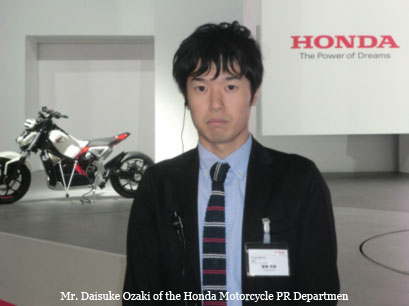
Kawasaki
The Kawasaki Heavy Industries Group has been in business for over 120 years, and is active in the manufactures of aircraft, railroad cars, ships, industrial machinery and other diversified product lines. The Motorcycle & Engine Company is the one where manufacturing and developing motorcycles in the Kawasaki Group.
At the October 25 press briefing, Mr. Kazuo Ota, the President of the Motorcycle and Engine Company, commented: “Kawasaki motorcycles leverage technology and know-how gained from our experience in building aircraft, and have always been designed to offer the deep sense of accomplishment that comes from controlling high-performance machines – in other words, the pursuit of being ‘Fun to Ride’”.
As one example of this stance, “Z900RS” was debuted at the Tokyo Motor Show as the latest offering in the long-standing Kawasaki “Z Series”. The first-generation Z model, the “Kawasaki 900 SUPER FOUR” (nicknamed the “Z1”), was marketed in 1972. To this day, these units continue to command high prices on the secondhand motorcycle market. According to President Ota: “This is one of evidences that the model has deep-rooted attractiveness, which is impossible to explain in terms of performance alone”. He added that all models in the Z Series are meticulously crafted to convey the feeling of being “Fun to Ride” primarily through the senses of sight, touch and hearing.
President Ota continued: “With the newly developed Z900RS as well, we channeled all possible energies into ensuring that this machine remains keenly in tune with the rider’s wishes and always being Fun to Ride”. Referring to all Z Series models: “These are motorcycles built to transform ordinary times into richer experiences by simply gazing at the machines or starting them up. Toward that end, the Z900RS stimulates ones senses and provides great pleasure.”
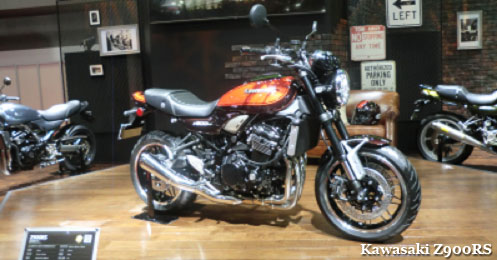
Kawasaki seized this occasion to announce the “Ninja 250” and “Ninja 400” – two new offerings in its popular Ninja series.

The Kawasaki booth exhibited an impressive range of Ninja and other models. They included the “Ninja ZX-10RR” (winner of three consecutive World Superbike Championship titles), the “Ninja H2 CARBON” (the first marketed motorcycle ever mounted with a supercharger) and other examples. When asking Mr. Youta Ishida of the Kawasaki Sales Promotion Group which models his team particularly hoped visitors would examine, he named the “Retro Sports Z900RS” – a machine rich in cutting-edge technology that also retains the classic style and looks of the iconic Z1 model.
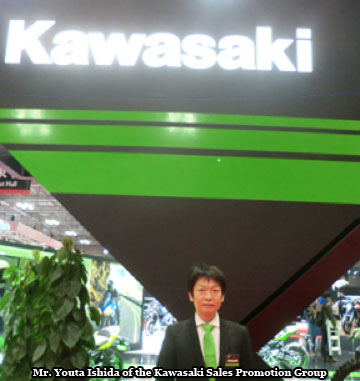
Suzuki
The concept chosen by Suzuki Motor Corporation as its core theme for this Tokyo Motor Show was, “EXCITEMENT for Everyone, in Everywhere”. Mr. Toshihiro Suzuki, Representative Director and President (CEO & COO),?appeared at the October 25 press briefing and noted: “Regardless of the differences in the roles of individual vehicles, they must all project qualities that consistently excite people. At Suzuki, our goal is to constantly work on new and advanced technologies while enhancing existing know-how, striving to exist as a company that always provides excitements and stimulations to our customers”.
The company also took advantages of this media gathering to introduce three new models – the “VS650X”, “SWISH” and “GSX-R125 ABS”. The SV650X is a concept model in the so-called “Neo Retro” category, combining a state-of-the-art tooled engine with traditional body looks. The SWISH is an upscale model scooter addressing the needs of users who demand riding ease and nimble maneuverability in urban environments, as well as those commuting to work by scooter. The GSX-R125 ABS is a lightweight high-performance supersport, featuring the GSX-R1000R ABS (the GSX-R Series flagship model) with full fairing and double-overhead-cam 4-valve engine.

The Suzuki booth was appointed to display a rich range of models, including the GSX-R1000R ABS super sports bike, “GSX-RR” MotoGP machine and other prestigious product line of the company. Regarding highly recommended model for visitors, Mr. Hiroyuki Kinoshita of the Suzuki Sales Promotion told: “That would be the SV650X. This is a model based on the cutting-edge technology of the SV650 ABS, which also newly incorporates Neo-Retro elements in its looks”.
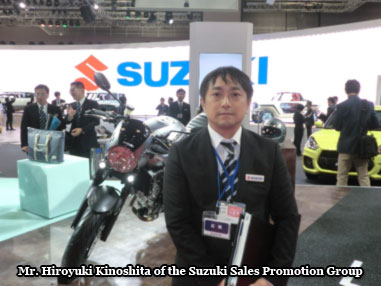
Yamaha
The theme adopted at the Yamaha Motor Corporation booth for this Tokyo Motor Show was: “Yamaha Future Garage: Resonate the Future”. True to that notion, the exhibitions included scooters, motorcycles, a Leaning Multi-Wheeler (LMW) model, electrically power-assisted bicycles and other shining examples fresh from the company’s self-styled “future garage”. Appearing at the October 25 press briefing, the President of Yamaha, Mr. Hiroyuki Yanagi, explained these developments, following by a special profile of two special new robots.
The first one was a humanoid model motorcycle robot. No restructuring of motorcycles is necessary to accommodate the robot; it is engineered to ride numerous different machines. At the Tokyo Motor Show in 2015, “MOTOBOT” was unveiled as the first-generation robot in this quest. The “MOTOBOT Ver. 2” displayed this time around is its evolved version. Remarkable progress made over the past two years is the ability of the MOTOBOT Ver. 2 that be able to operate in racetracks at speeds of up to 200km/h.
The second Yamaha robot was the “MOTOROiD” – a creation in which the motorcycle itself is transformed into a robot. Beside self-support functions enabling the unit to maintain its own balance, it is also instilled with visual and voice cognition functions. When President Yanagi issued the verbal order, “MOTOROiD, stand up”, the kickstand automatically separated from the machine. He then said “MOTOROiD, come on”, and the machine moved towards him. Also he demonstrated MOTOROiD’s durability against toppled over by pushing it from the side.
Mr. Yanagi explained that while MOTOBOT was developed aiming at autonomous driving in range of medium to high speeds, the MOTOROiD aims to provide assistance for riders at lower speeds (and particularly at startup, stopping and other unstable moments) and increasing the sense of interaction between rider and machine. Finally, President Yanagi told the MOTOROiD, “Thank you MOTOROiD, you can go back” and the machine resumed its original position.

The Yamaha booth exhibited the “NIKEN” large-size LMW, “YZR-M1” MotoGP racing bike and lots of other selected models. Asking Mr. Naoto Horie of the Yamaha Motor PR Group which products he hoped visitors would particularly view, he cited the MOTOROiD concept model. That desire reportedly stems from the core role envisioned for this concept model in gearing up from the challenges of the “Growing World of Personal Mobility” targeted to date to those of the “Increasingly Expanding World of Personal Mobility.”
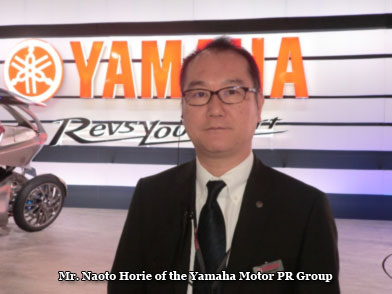
TOKYO CONNECTED LAB 2017
Underlying the “BEYOND THE MOTOR”, the keynote theme of this latest Tokyo Motor Show, was the desire to organize an event positioned to expand the traditional value and joys of automobiles. Toward that end, JAMA focused on gathering cutting-edge knowledge capable of bridging the lines between industries to help pave the way to new innovations and businesses.
Exhibitions directly reflecting this theme were the “TOKYO CONNECTED LAB 2017”. There were three separate programs where guests can participate and experience the new values of mobility and connections to society that the future mobility may bring. The programs were titled “THE FUTURE”, “THE MAZE” and “THE MEET UP”.
“THE FUTURE”, a unique interactive exhibit, was designed as a large dome-shaped space capacity of about 300 guests. There is a 360-degree screen projecting possible future scenes of autonomous driving, car sharing, personal mobility, smart logistics and other visions of “Mega-City Tokyo” in 2020, as well as a taste of the even greater mobility-driven society predicted to emerge in the years after that.
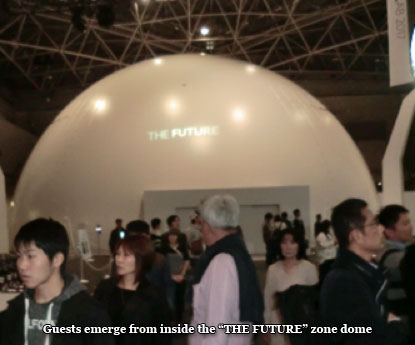
“THE MAZE” was a program enables 30 guests at a time to individually explore a fully connected, maze-like Tokyo of the future by driving their own connected cars, in the virtual reality. The guests will virtually experience advancement of safety and comfort through connected technologies like, Vehicle-to-Vehicle/Vehicle-to-Infrastructure/Vehicle-to-Pedestrian communications, with some mobility services in a game-like format.
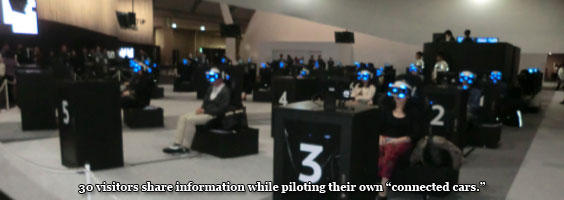
“THE MEET UP” was a series of talk sessions where number of business leaders and trendsetters from various different industries/fields discuss together with visitors about the coming expansion and potential of mobilized society in the future.
TOKYO CONNECTED LAB 2017 was staged in the West Hall of Tokyo Big Sight. The walk to this area, after viewing the booth of the four Japanese motorcycle manufacturers in the New East Halls, was quite a hike. Taking that into consideration, a free shuttle bus was operated for the elderly, physically weak and other special needs visitors. Also, the show was freely accessible for persons with physical disabilities.
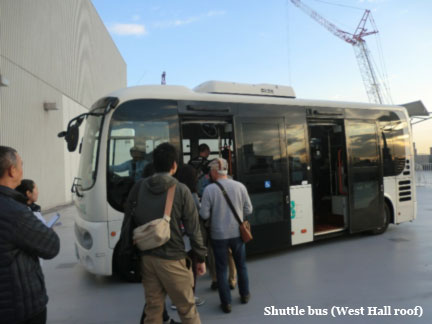
Visitors making the rounds of this vast exhibition site can typically expect to work up a considerable appetite and thirst for refreshments. Tokyo Big Sight normally responds to such needs with a decent number of on-site convenience stores and restaurants (for example, both sides of the East Halls second level corridor are lined with spots to grab a bite and wash them down with various beverages). During the Tokyo Motor Show, these standing concessions were further complemented with a considerable volume of stands serving distinctive snacks and other food selections.
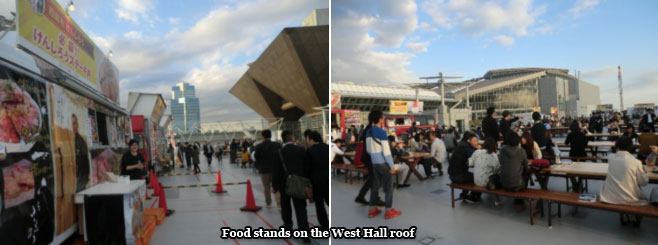
Throughout its 10-day run, the 45th Tokyo Motor Show drew a grand total of 771,200 visitors (averaging around 82,000 persons daily), eventually coming to a festive close on November 5.
